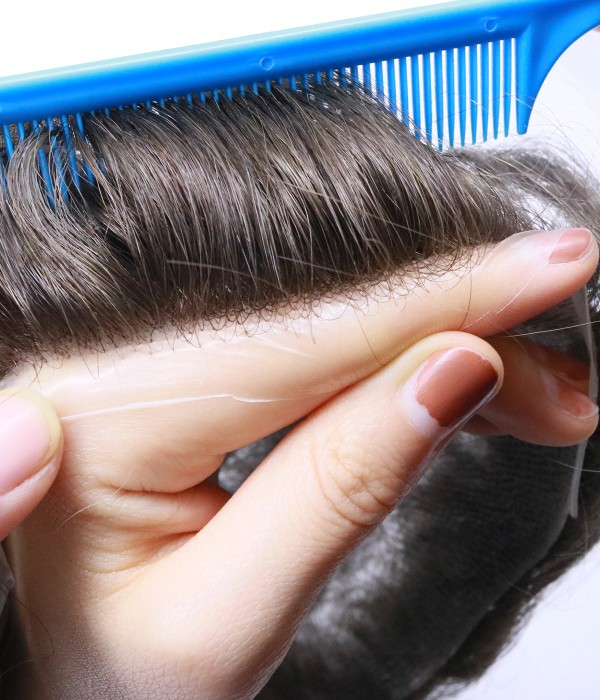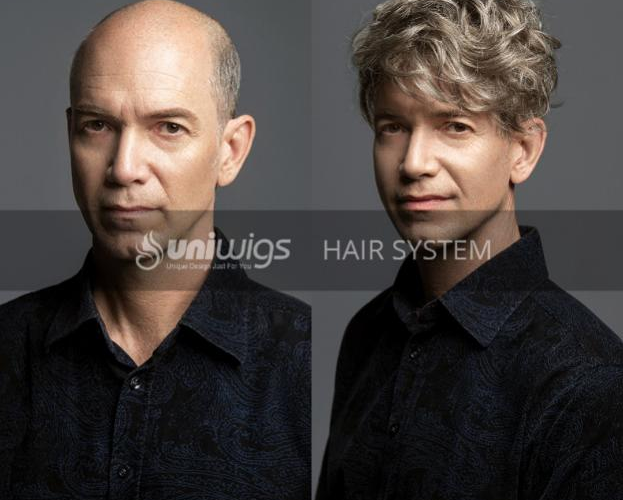In the last post, we talked about using a template when customizing hair systems. The most important step in template making is the choice of the hairline. So how to choose a fitting hairline?
Before making the template, there are some preparations. The first step is to fully understand the customer’s desired hairstyle, hair loss type, and lifestyle. Then draw the wig as a whole. This work will help you a lot. Especially because the effect of the front hairline on image transformation is huge, it’s very important to keep the hairstyle as natural as possible, meanwhile, the most important thing is you have to compensate for a customer’s hair loss.
As everyone knows, hair can shape your face and soften the lines. It also allows the bones and contours of the face to be more harmonize with the body. In a general way, males have larger skulls than females, the hump and curve of the back head are also more pronounced. Therefore, when conducting hair system design, the most important thing is the design of the hairline. Some areas of hair loss can be seen in the hairline, but finding a customer’s original hairline is not easy. At this time, you need to pay attention to your attitude, do not be impatient. Make sure the customer sees your professionalism. After all, when wearing a hair system, the hairline is an important factor in determining the overall hairstyle. Finding each person’s features based on their face shape is an essential skill for a qualified hair system stylist.
For a more accurate haircut, the point in between the top of the forehead and the chin must be the eyes. The distance between the eyes should be the same as the measured distance from the bridge of the nose to the tip of the nose, and the distance from the mouth to the chin should be about a quarter of the length of the face. The length of the ear is the same as the nose. The ear and the nose are at the same height. Judge the line between the forehead and the head in this proportion.
Before drawing the customer’s head and design it, you need to decide how to wear the hair system. The design and size of the hair systems are decided according to the way it is worn. To fully explain to customers the advantages and disadvantages of various ways to wear. Only to let customers understand, can let the customer wearing a hair system to reduce discomfort, enhance satisfaction.
Hairlines come in the following shapes;
Circular shape
For template making, circular design is the most convenient, so it is welcomed by designers. But there is a disadvantage that customers can not do a slicked back, but this disadvantage can be made up through the change of hairstyle.
Besides, the hairline in any hair system is somewhat unnatural, so the round hairline is by far the most commonly used. In particular, clip-on toupees, which are fastened to one’s hair instead of shaving the hair where the hair is losing, usually use a circular shape.
M-shape
An “M” shape is the most common type of hair loss and can become an “L” or “R” shape depending on whether the hair loss is more severe on the left or right side.
The “M” hairline is considered natural, but it’s also one of the most dangerous. Toupees are usually woven with nets made of urethane or silica gel, which makes it difficult to create a natural hairline like the original hair. It is also difficult to handle broken hair properly, so it tends to look unnatural. An “M” hairline is also not appropriate for a Slicked back but can be recommended for a natural drop.
U-shape
U-shape is common in people with a long face and prominent cheekbones, which is a symptom of hair loss on both sides of the forehead. It is necessary to be careful when choosing a hairline. It is recommended to refer to an m-shape hairline.
This is the most common pattern used by most men with hair loss. If the hair loss area and the current hairline boundary point are more consistent, the effect will be more natural. But if the original hairline is not harmonious, a toupee is made too small, it can look like M-shaped hair loss when you put it back on. It’s important to minimize the line between hair loss and the current hairline.
For example, people with hair loss that is too wide across the forehead will not have a standard U-shaped hairline and will instead look like a Circular hairline.
Therefore, in the pursuit of a U-shaped hairline, the hairline will narrow, wearing a wig will have the effect of M-shaped hair loss. So hair loss in a wide range of people to avoid using u-shaped hairline.
C-shape
C-shape is a common type of hair loss in people with a low volume of hair and a long time of hair loss. Hair loss is more severe in the middle of the forehead, which should be taken into account when designing the hairline.
L-shape
L-shape is a more common type of people with left hair gap. In the design of the hairline on the basis of the M-shape to let the line in the left be deeper. The L-shape is the result of the left side gradually becoming concave after several years of development from the initial M-shape, so when design it, you should refer to the M-shape.

R-shape
R-shape is a more common type of people with the right hair gap. In the design of the hairline on the basis of the M-shape to let the line in the right be deeper. The L-shape is the result of the right side gradually becoming concave after several years of development from the initial M-shape, so when design it, you should refer to the M-shape.
W-shape
W-shape is commonly seen on the face or body hair, thin face of the crowd. The middle of the hairline is prominent, and this shape occurs when hair loss is severe on both sides. It is also common in people with a middle hairline.
The prominent hairline in the middle can serve all sorts of purposes when wearing a toupee and also ease the technical difficulties of attaching a toupee.
That’s all hairlines’ shape. And therein lies a problem: Why make toupees bigger?
A tape toupee involves shaving the hair where the hair is falling out, therefore, the size of the toupee should also match the hair loss area.
A fixed toupee is always made toupees bigger and attach to healthy hair to prevent hair loss later in daily life.
A clip-toupee in order to secure the toupee to healthy hair other than the hair loss area, it should also be made to the maximum extent possible to prevent traction alopecia caused by the clip attaching to the fragile hair.
In addition, toupees should be bigger and bigger in the order of tape type, fixed type, and clip type.
That’s all knowledge about how to choose a front hairline. I hope you can gain useful knowledge from it. If there are any problems please connect with sarah@uniwigs.com. We are waiting for you!
